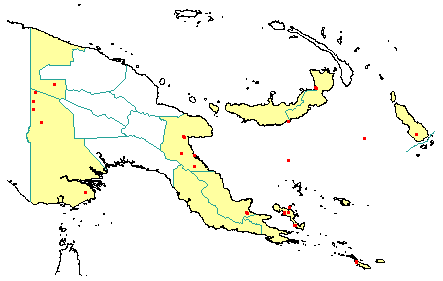
in PNGplants database
PNGTreesKey – Mastixia kaniensis Melch. |
Barry Conn (NSW) & Kipiro Damas (LAE).
Guide to trees of Papua New Guinea
Copyright held by the authors, National Herbarium of New South Wales, and Papua New Guinea National Herbarium
Botanische Jahrbucher für Systematik, Pflanzengeschichte und Pflanzengeographie Vol. lx.: 172 (1925)
Family: Nyssaceae
Dicotyledon
Timber Group: Non-timber species
Field Characters: Large canopy tree (25-35 m high); Bole cylindrical (up to 60 cm diam.); straight (bole up to 25 m long); buttresses buttresses absent; spines spines absent; aerial roots aerial roots absent; stilt roots stilt roots absent; Bark grey or brown, rough, slightly scaly or flaky, fissured, or slightly furrowed cork; Subrhytidome (under-bark) yellow or green; less than 25 mm thick, 15.0 (c.); bark blaze consisting of one layer; faintly to non-aromatic; pleasant (aroma like sugar-cane); outer blaze pale orange, brown, or grey, markings absent, fibrous; inner blaze pale orange, brown, or grey, markings absent, fibrous; bark exudate (sap) present, yellow (pale (slightly golden-coloured) or colourless, not readily flowing (spotty), colour not changing on exposure to air, sticky; terminal buds not enclosed by leaves.
Indumentum: Complex hairs absent; stinging hairs absent; mature twig indumentum (hairs) absent.
Leaves: Leaves spaced along branches, opposite (in pairs, opposite one another on the branchlet) (to subopposite), simple (a leaf composed of a single blade); petiole present, not winged, attached to base of leaf blade, not swollen; leaves broadest above middle or sometimes broadest at or near middle, (7.0-) 12.0-15.0 cm, (2.5-) 5.5-6.5 cm; symmetric, entire, not dissected or lobed, acuminate (shortly), venation pinnate, secondary veins open, prominent, intramarginal veins absent; leaves lower surface pale green, upper surface dark green (glossy), indumentum (hairs) absent; absent; domatia absent; stipules absent.
Flowers: Inflorescence terminal, flowers on a branched axis, cones absent; flowers bisexual, stalked, flowers with many planes of symmetry, 4.0-6.0 mm long, diameter small (up to10 mm diam.) (5-8 mm diam.); perianth present, with distinct sepals and petals whorls, inner perianth white, pale yellow, or pale green; 5, free; stamens 5, present, free of each other, free of the perianth; ovary inferior, carpels joined (when more than one), locules 1; styles solitary, 1.
Fruits: Infrutescence arranged on branched axis, fruit 20.0-28.0 mm long, dark blue or purple (when mature), not spiny, fleshy, simple, indehiscent, drupe; seeds 1, about 10 mm long, not winged, narrow (longer than wide), seed 1-10 mm diam. (6-8 mm diam.).
Distribution: West Sepik, Morobe, Western, Central, Northern, Milne Bay, Papuan Islands, New Britain & Bougainville.
 | Botanical records in PNGplants database |
Notes: Notes The taxon that occurs in Papua New Guinea is Mastixia kaniensis Melch. Subsp. kaniensis. The genus Mastixia was previously classified in the family Cornaceae.